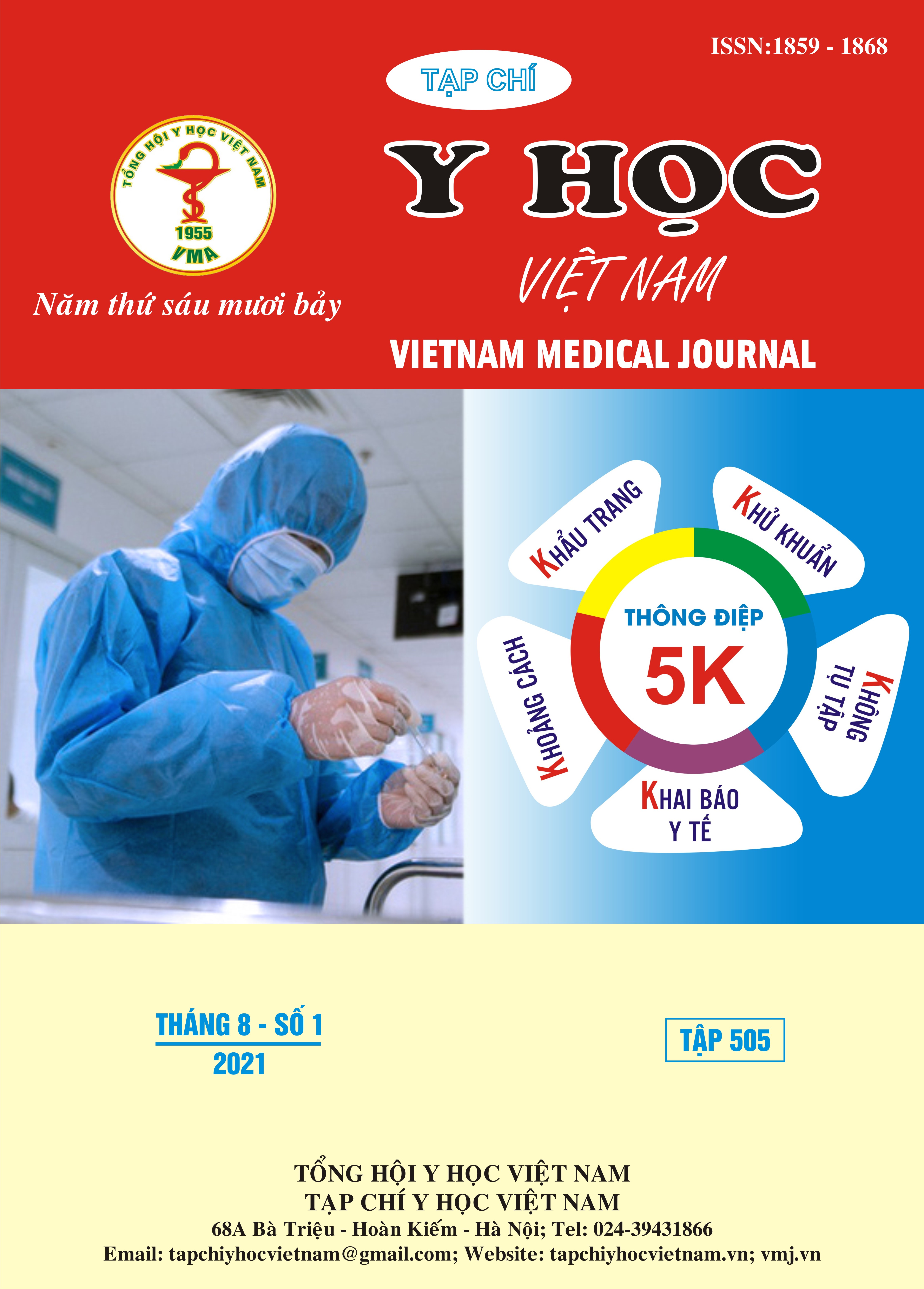ĐẶC ĐIỂM LÂM SÀNG, CẬN LÂM SÀNG TIÊU CHẢY CẤP PHÂN MÁU Ở TRẺ EM TẠI BỆNH VIỆN ĐA KHOA ĐỨC GIANG
Nội dung chính của bài viết
Tóm tắt
Tiêu chảy cấp phân máu là tình trạng nhiễm khuẩn đường tiêu hóa thường gặp ở trẻ em, gây ảnh hưởng đến sự phát triển của trẻ. Mục tiêu nghiên cứu: mô tả đặc điểm lâm sàng, cận lâm sàng tiêu chảy cấp phân máu ở trẻ em. Đối tượng và phương pháp nghiên cứu: Nghiên cứu tiến cứu mô tả một loạt ca bệnh gồm 64 bệnh nhân được chẩn đoán tiêu chảy cấp phân máu vào điều trị tại khoa Nhi bệnh viện đa khoa Đức Giang từ tháng 08/2020 đến tháng 05/2021. Kết quả: Tuổi trung bình mắc bệnh là 16,6 ± 14,6 (2-64) tháng, trong đó 79,6% trường hợp mắc bệnh dưới hai tuổi. Tỉ lệ mắc bệnh trẻ trai/gái là 1,7:1. Trẻ đi ngoài phân có nhầy máu chiếm 100%. Các triệu chứng lâm sàng thường gặp là chán ăn 79,7%, sốt 76,6%, mất nước 35,9%, đau bụng 35,9% và nôn 34,4%. Các triệu chứng khác kèm theo như hậu môn sưng đỏ 45,3%, mót rặn khi đi ngoài 40,6%, thiếu máu 37,5% và bụng chướng 18,8%. Xét nghiệm máu có tăng bạch cầu, tăng CRP, hạ Kali, hạ Natri với tỷ lệ lần lượt là 54,7%, 70,3%, 17,1%, 1,6%. Tỷ lệ bạch cầu, hồng cầu trong phân là 100% và 78,1%. Cấy phân có Salmonella chiếm 4,7%. Kết luận: Trẻ tiêu chảy cấp phân máu thường có biểu hiện chán ăn, sốt, hậu môn sưng đỏ, mót rặn khi đi ngoài. Xét nghiệm máu thường gặp tăng bạch cầu và CRP. Tỷ lệ phát hiện vi khuẩn qua nuôi cấy phân thấp.
Chi tiết bài viết
Từ khóa
Tiêu chảy cấp phân máu, trẻ em, nhiễm khuẩn
Tài liệu tham khảo
2. Bùi Thị Hồng Thắm, Nguyễn Anh Tuấn. Hoàng Lê Phúc. Đặc điểm của tiêu máu ở trẻ em từ 2 - 6 tháng tuổi tại khoa Tiêu hóa BV Nhi đồng I. Tạp chí nghiên cứu y học. 2010;15(3): 160-164.
3. Nguyễn Phước Trưởng. (2015). Đặc điểm dịch tễ, lâm sàng và vi sinh tiêu chảy cấp phân máu ở trẻ nhỏ.Luận văn bác sĩ chuyên khoa cấp II. Trường đại học Y Dược Thành phố Hồ Chí Minh.
4. Nguyễn Phan Lương. (2018). Nghiên cứu một số đặc điểm dịch tễ học, lâm sàng, cận lâm sàng tiêu chảy cấp do vi khuẩn ở trẻ em điều trị tại bệnh viện nhi trung ương. Luận văn thạc sỹ y học. Trường đại học Y Hải Phòng.
5. Nguyễn Thị Thanh Tâm, Nguyễn Thị Việt Hà, Đánh giá một số yếu tô nguy cơ của tiêu chảy kéo dài nhiễm khuẩn ở trẻ em 6 – 24 tháng tuổi tại bệnh viện Nhi trung, Tạp chí Y học thực hành. 2017; 1048: 87-90
6. Lê Công Dần, Ngô Thị Thi, Bùi Thị Mùi và cộng sự. Tỷ lê nhiễm và mức độ đáp ứng kháng sinh của các vi sinh vật gây bệnh ở bệnh nhân mắc tiêu chảy tại bệnh viện nhi Trung ương. Tạp chí nghiên cứu y học. 2006;44(4): 52-55
7. Arvola T, et al (2006), "Rectal bleeding in infancy: Clinical, allergological, and micrbiological examination.”, Pediatrics, (117), pp. 760-768,
8. Hoàng Ngọc Anh, Đặng Thị Thúy Hà, Lương Thị Nghiêm. Đặc điểm lâm sàng, cận lâm sàng của bệnh nhi tiêu chảy cấp tại bệnh viện Nhi Trung ương. Tạp Chí Nghiên cứu và Thực hành Nhi khoa. 2020; 4(3): 50-54
9. Addisu Assefa, Mengistu Girma (2019). “Prevalence and antimicrobial susceptibility patterns of Salmonella and Shigella isolates among children aged below five years with diarrhea attending Robe General Hospital and Goba Referral Hospital, South East Ethiopia” Trop Dis Travel Med Vaccines 5, 19 (2019). https://doi.org/10.1186/s40794-019-0096-6


